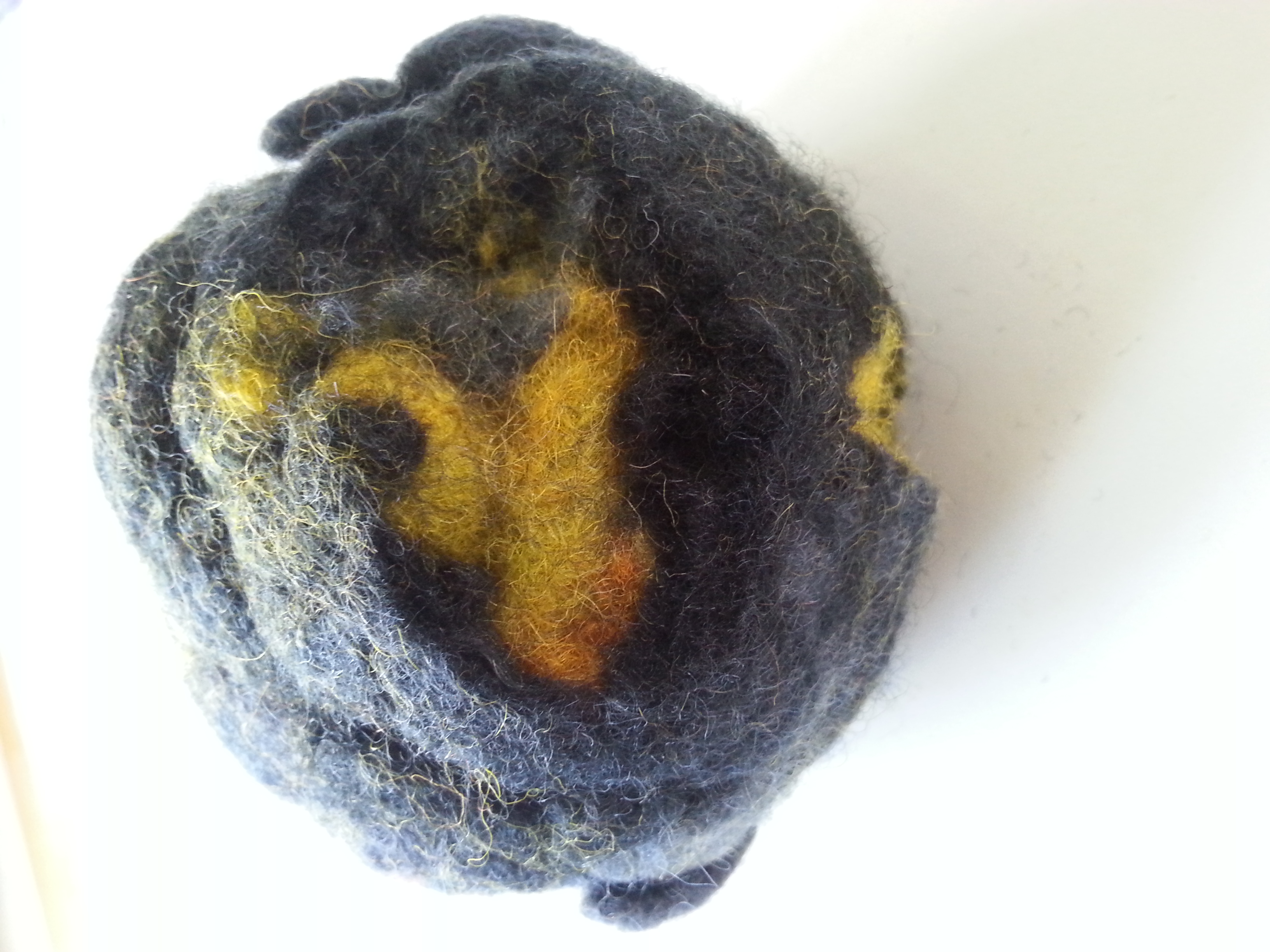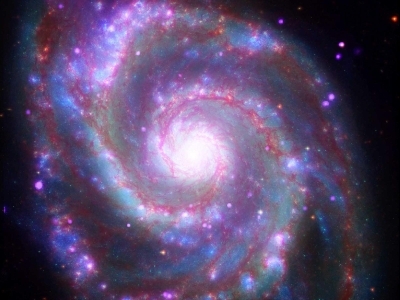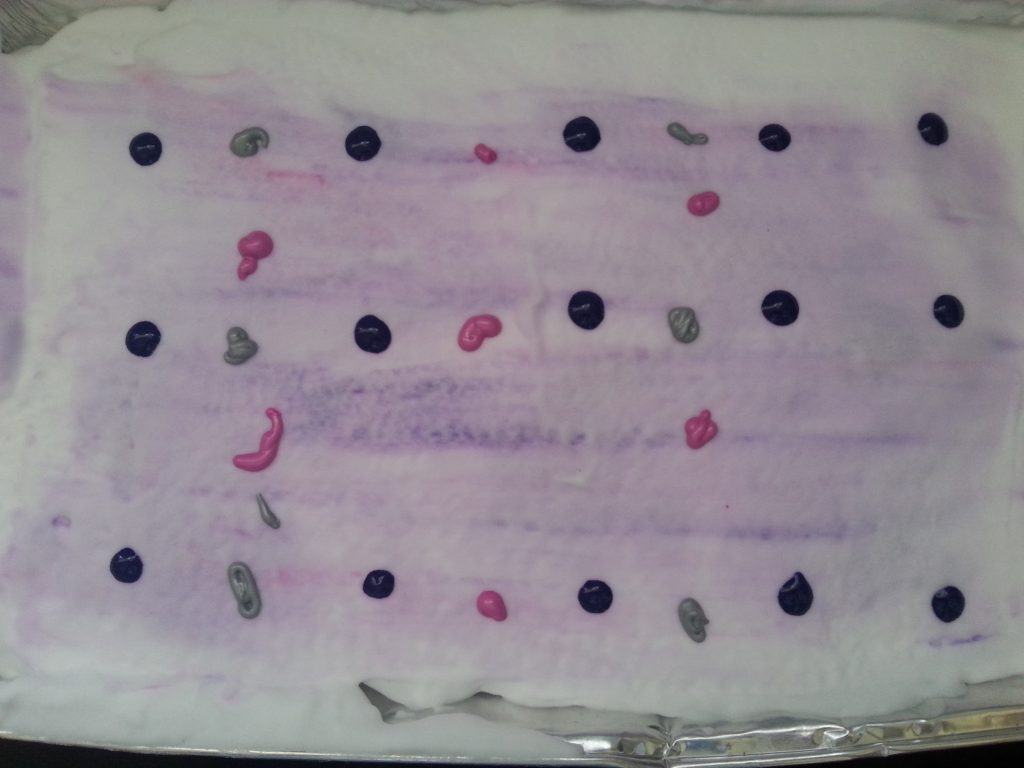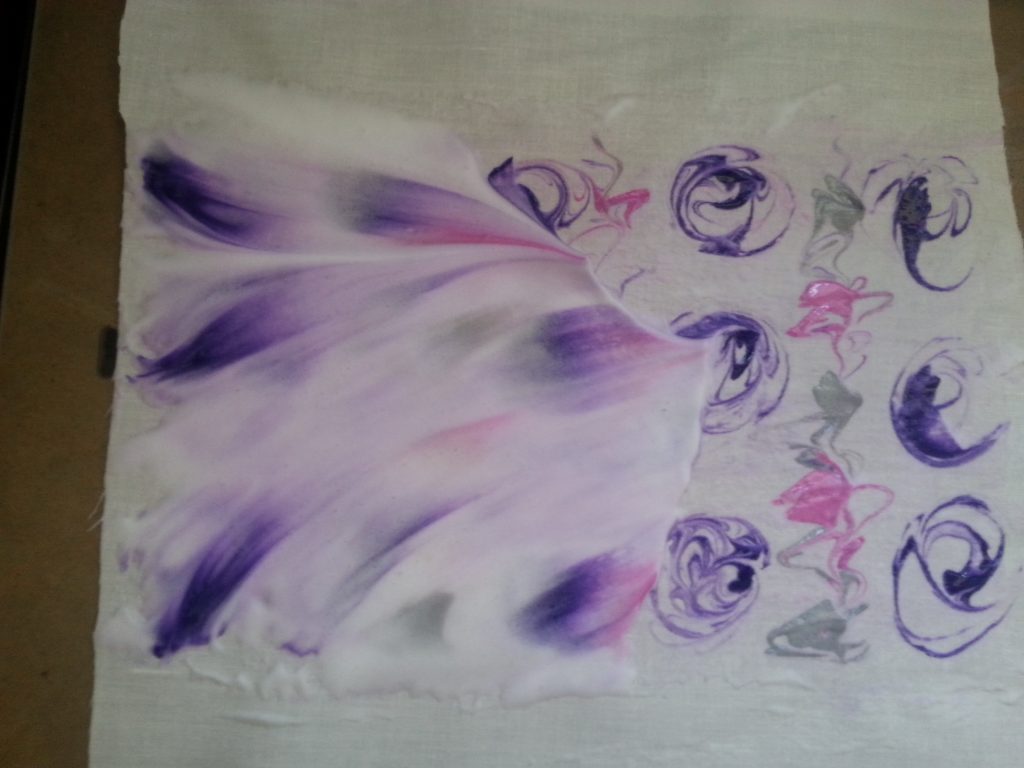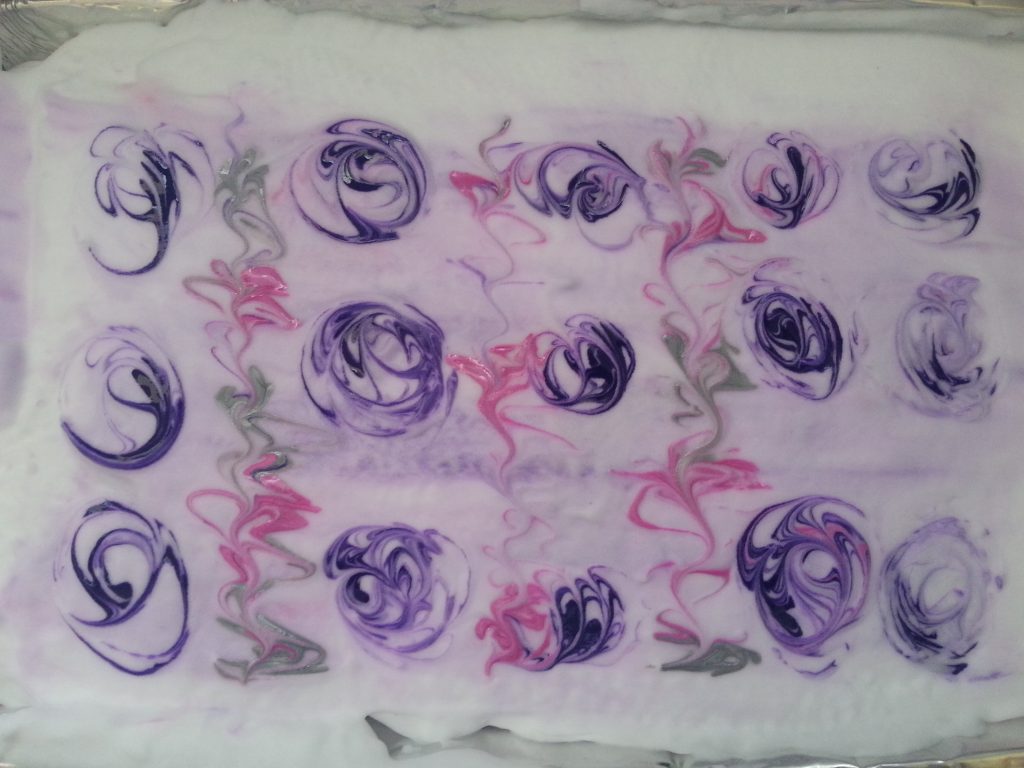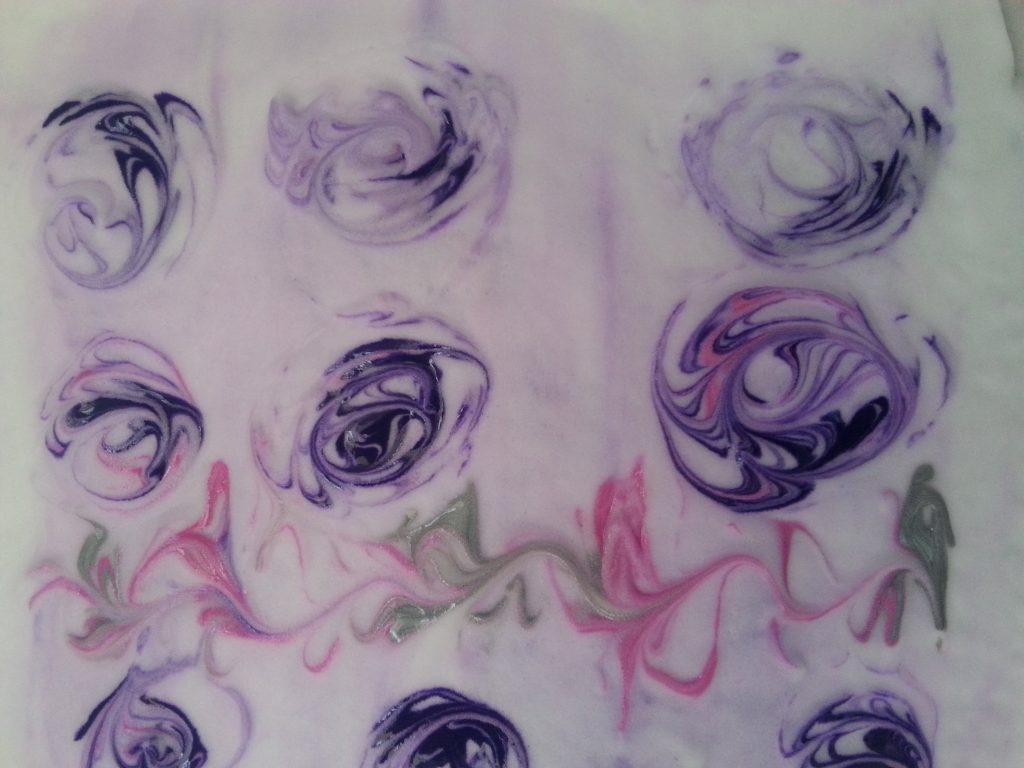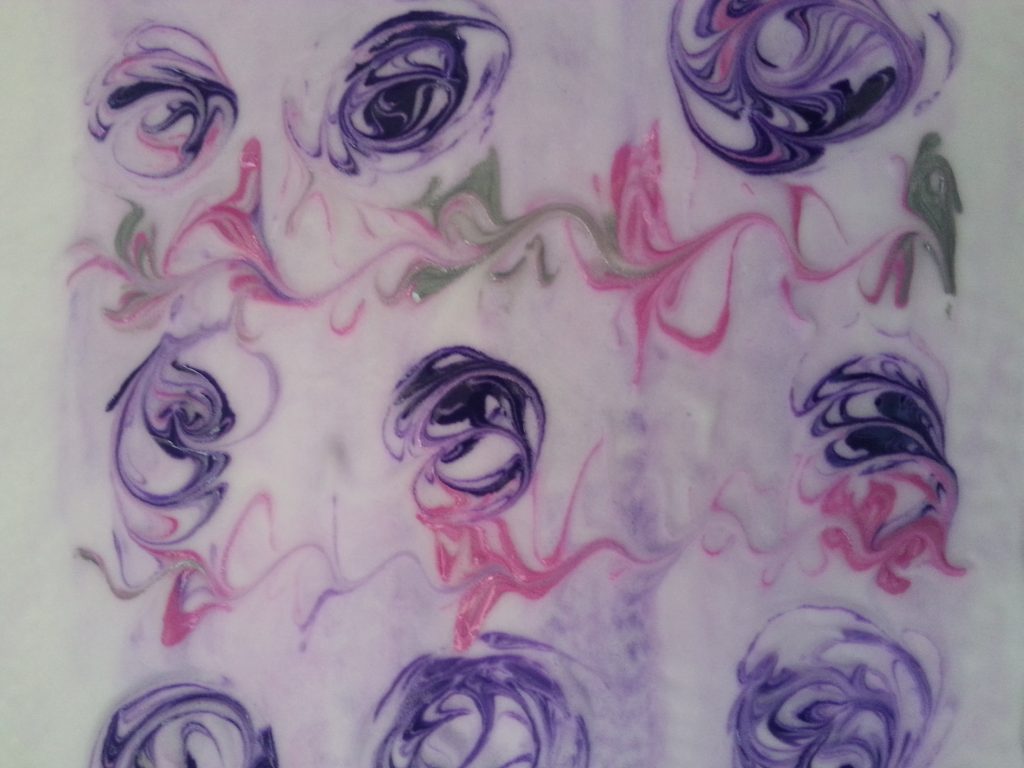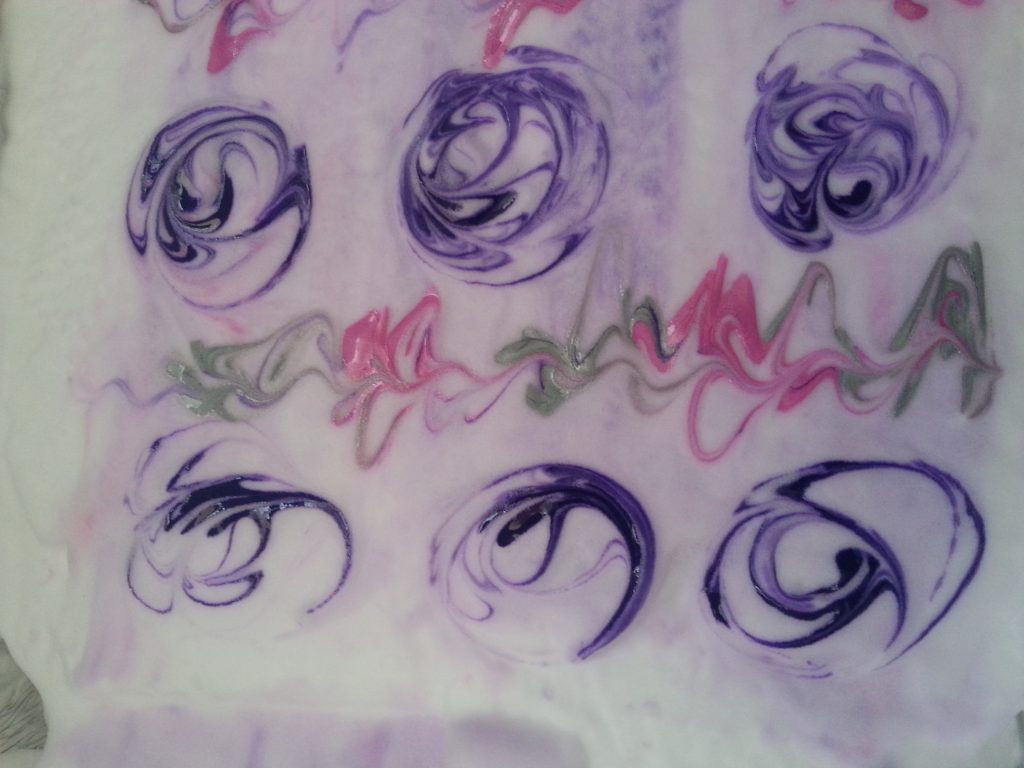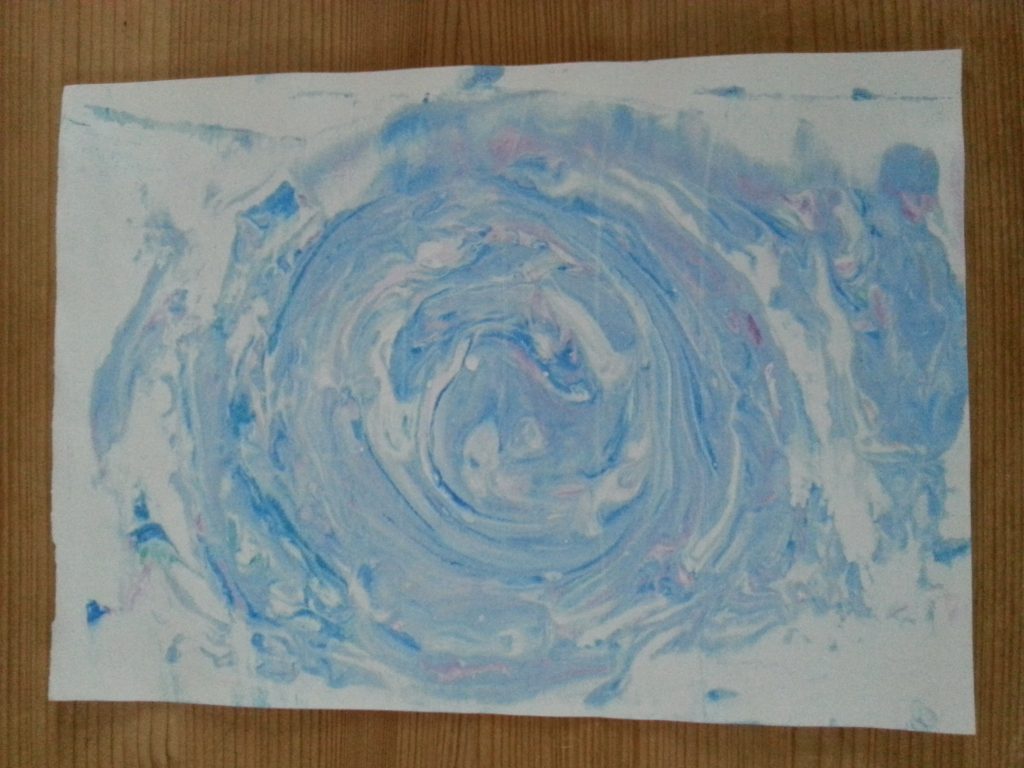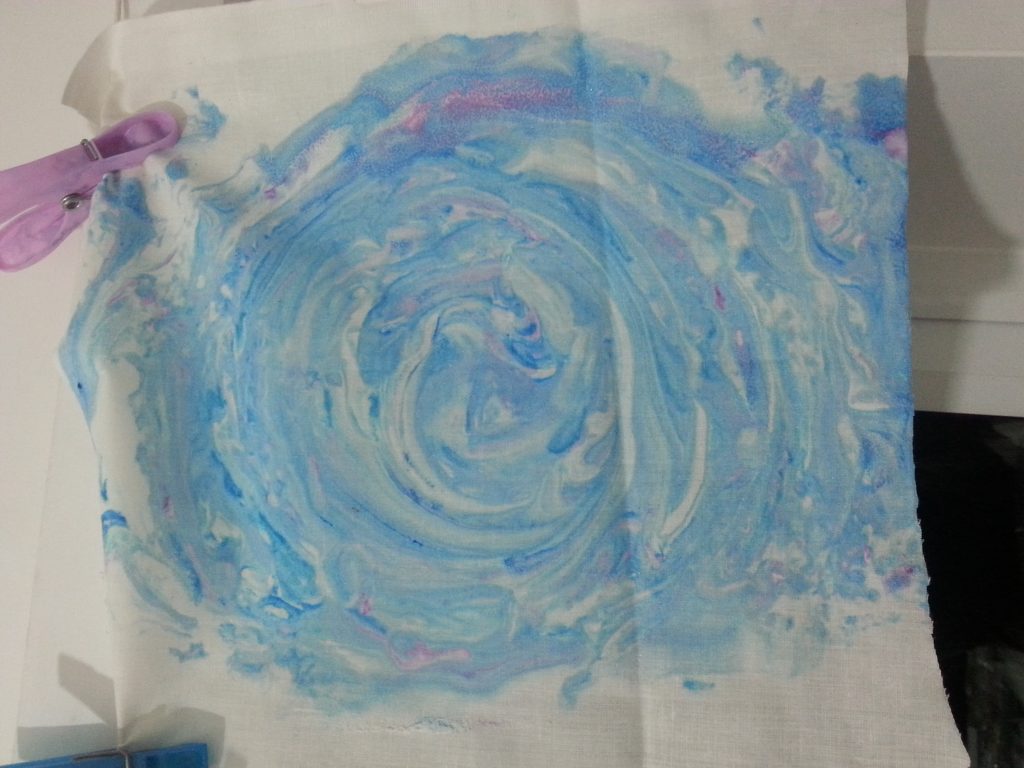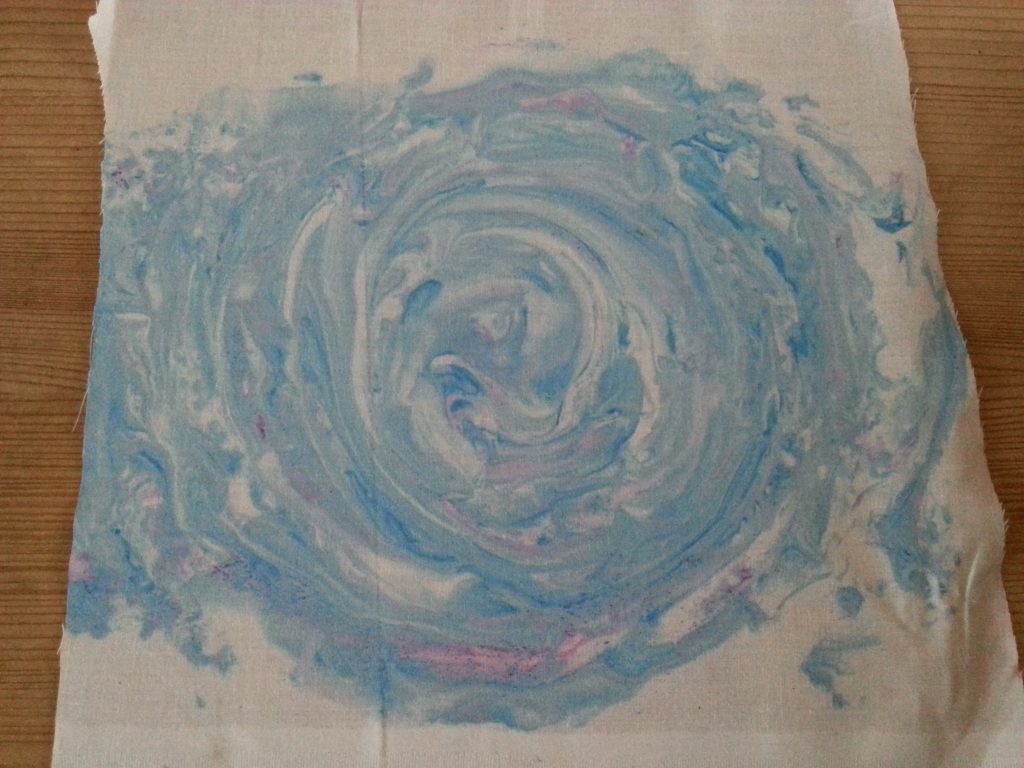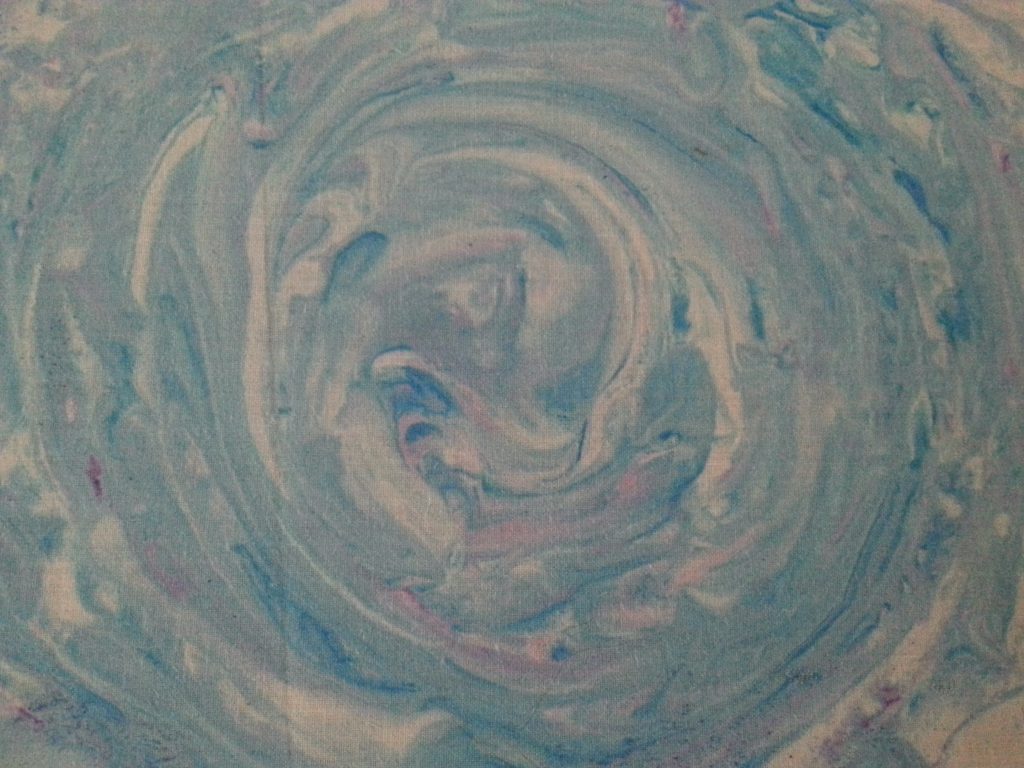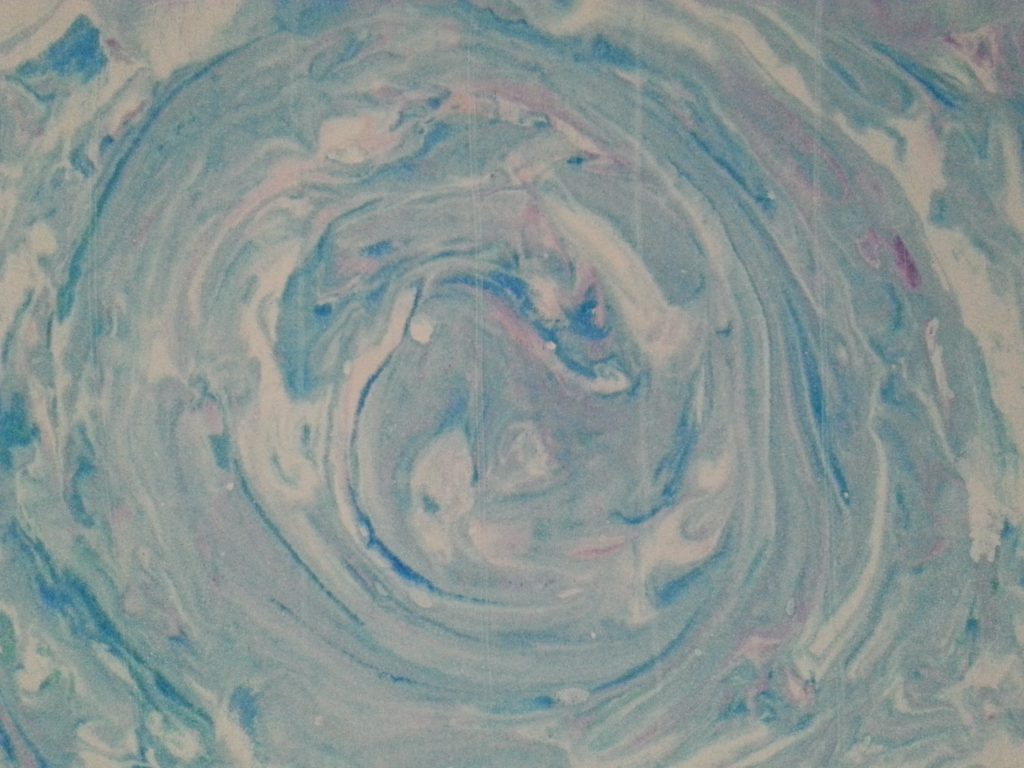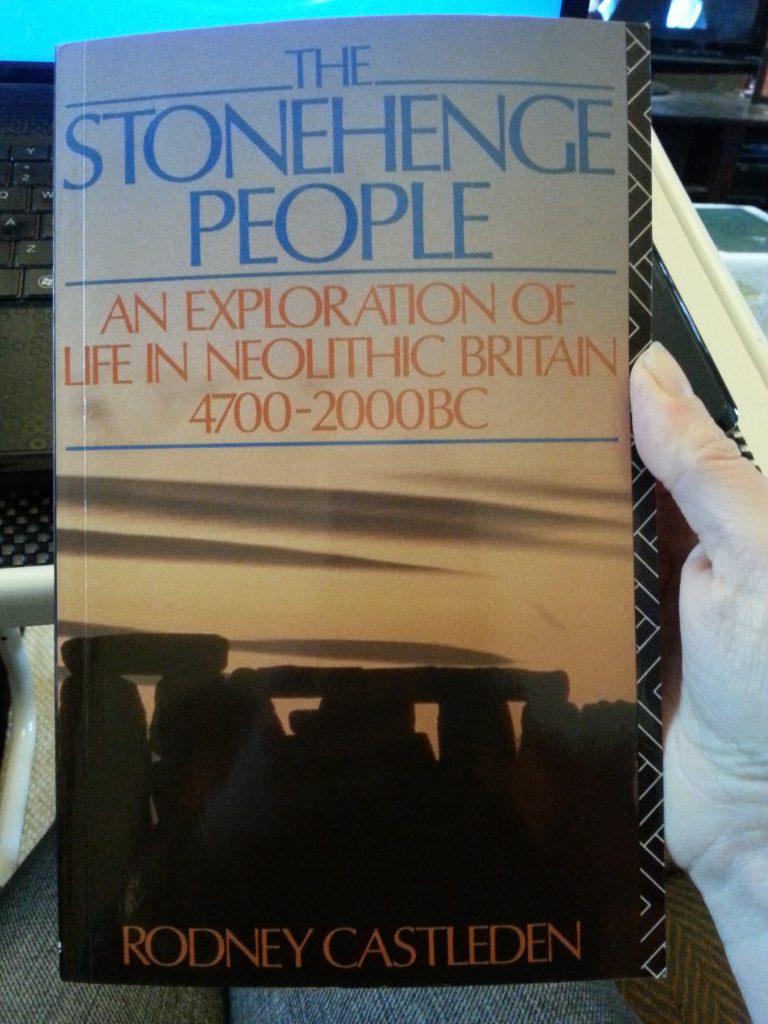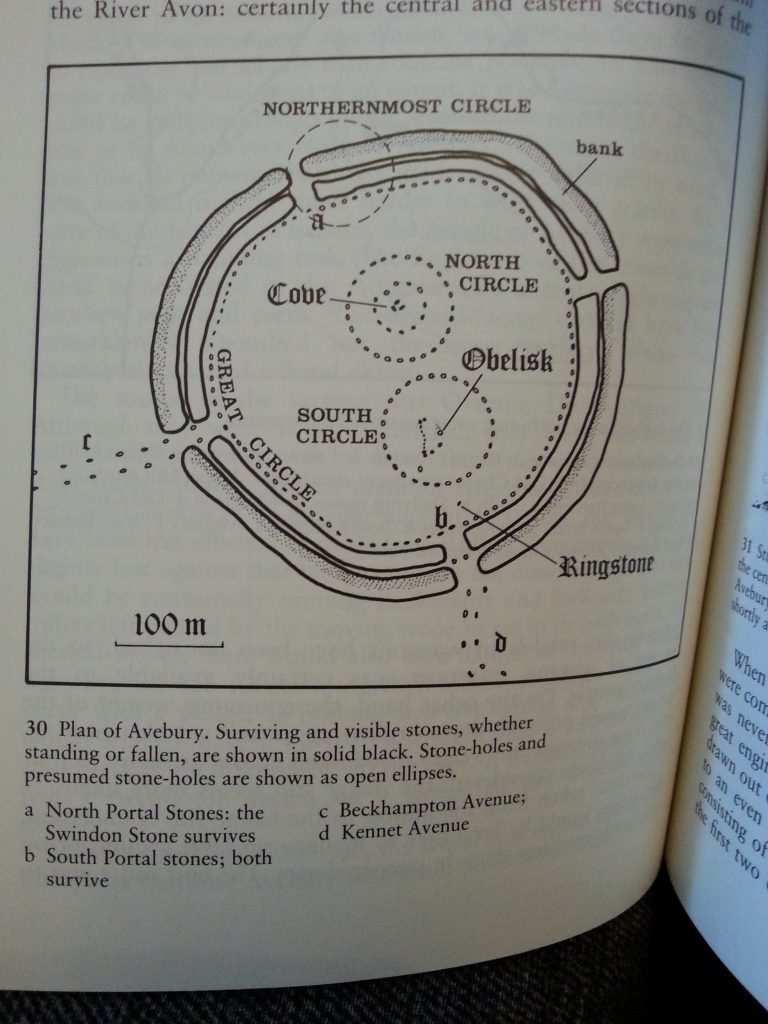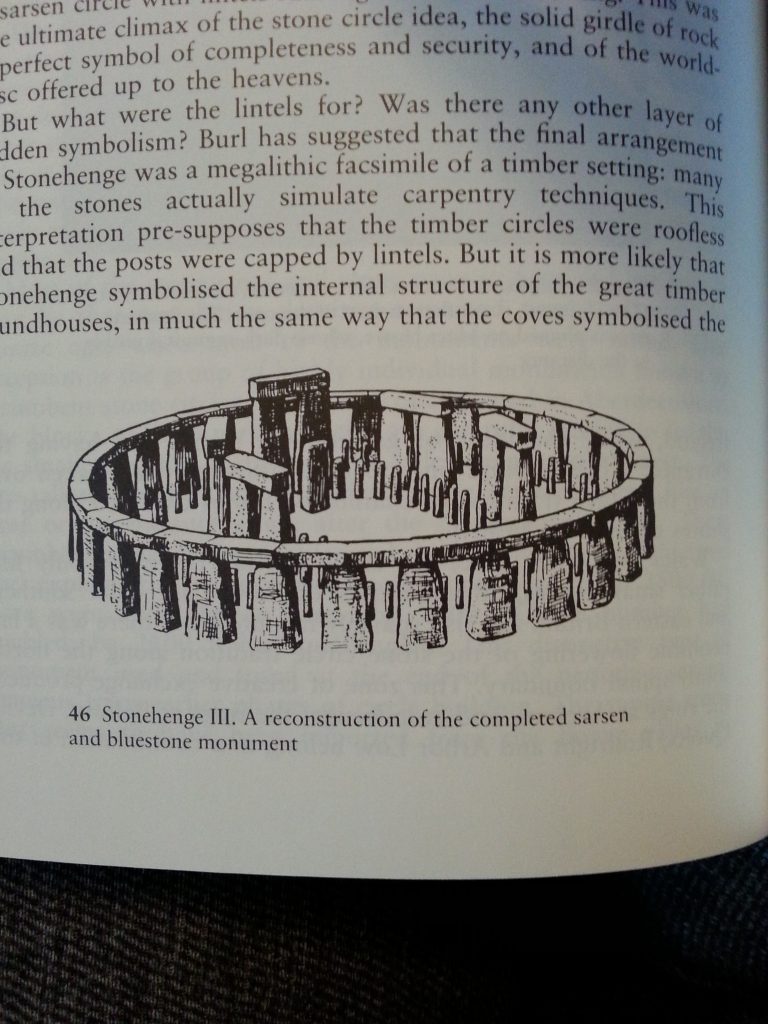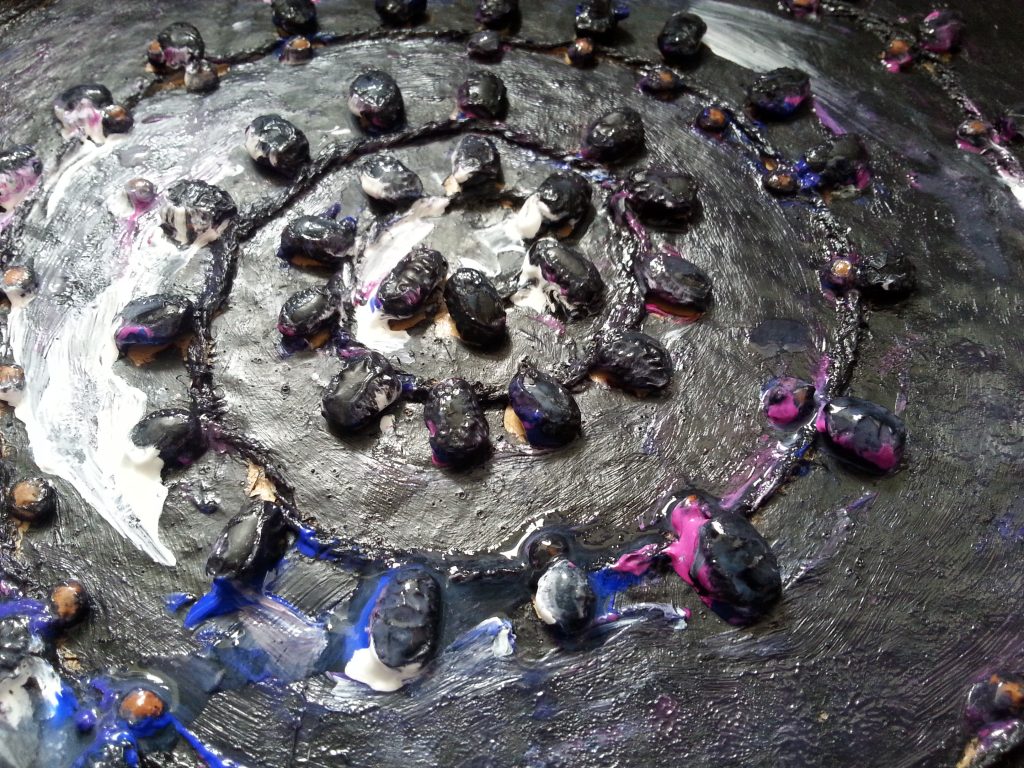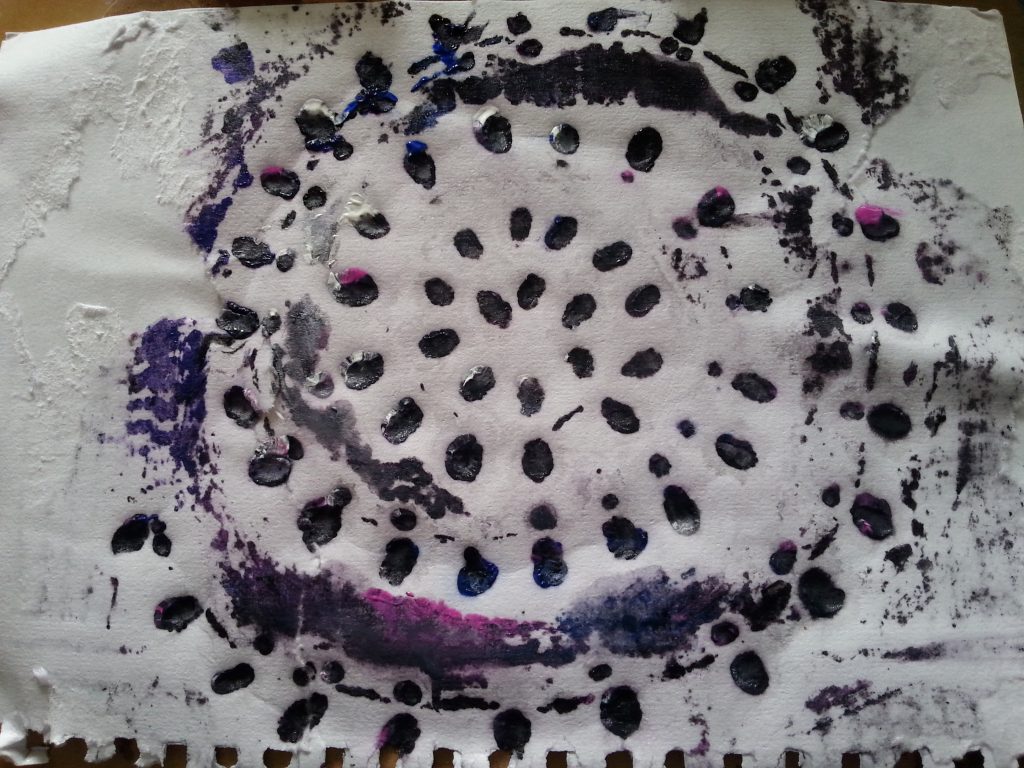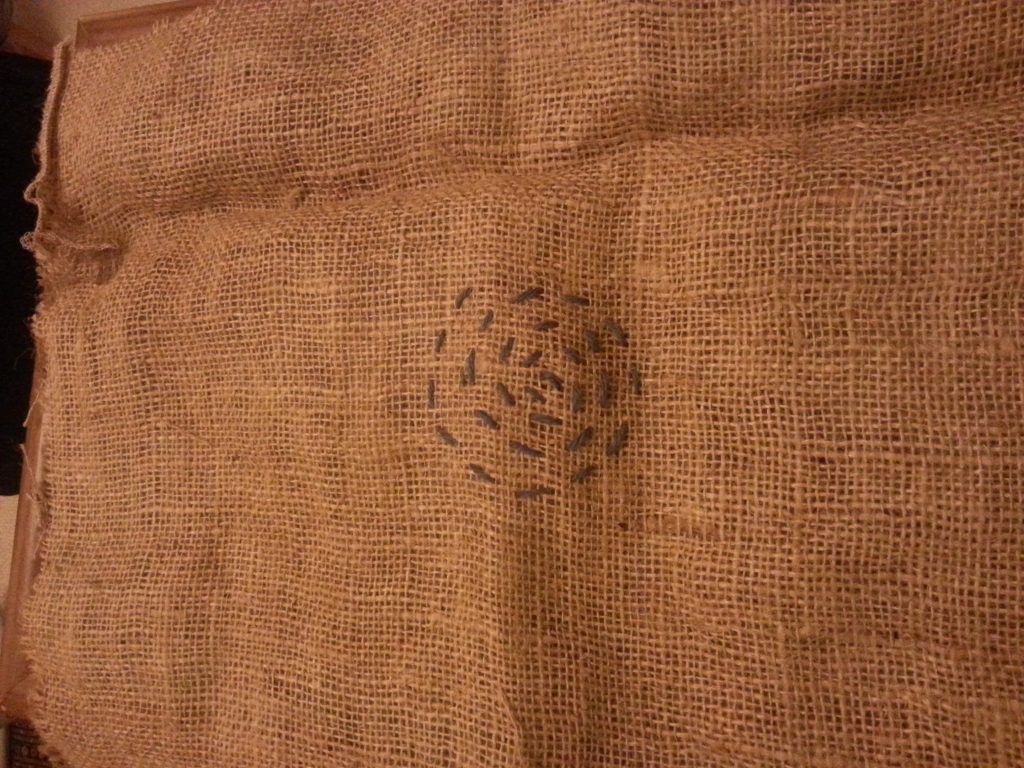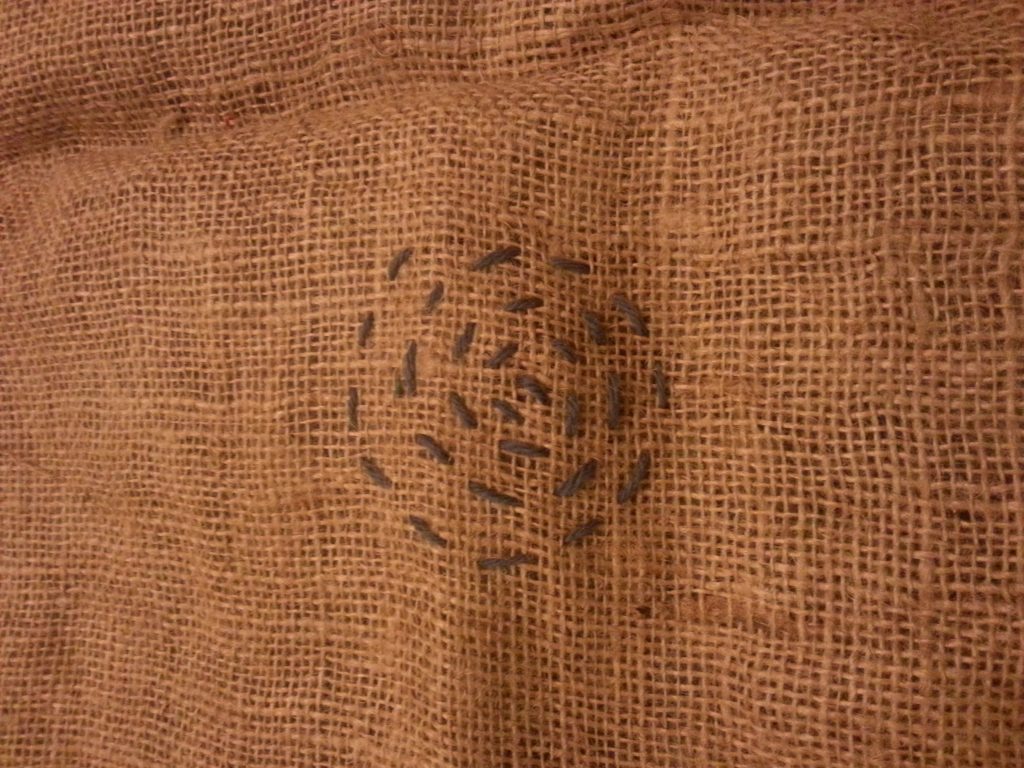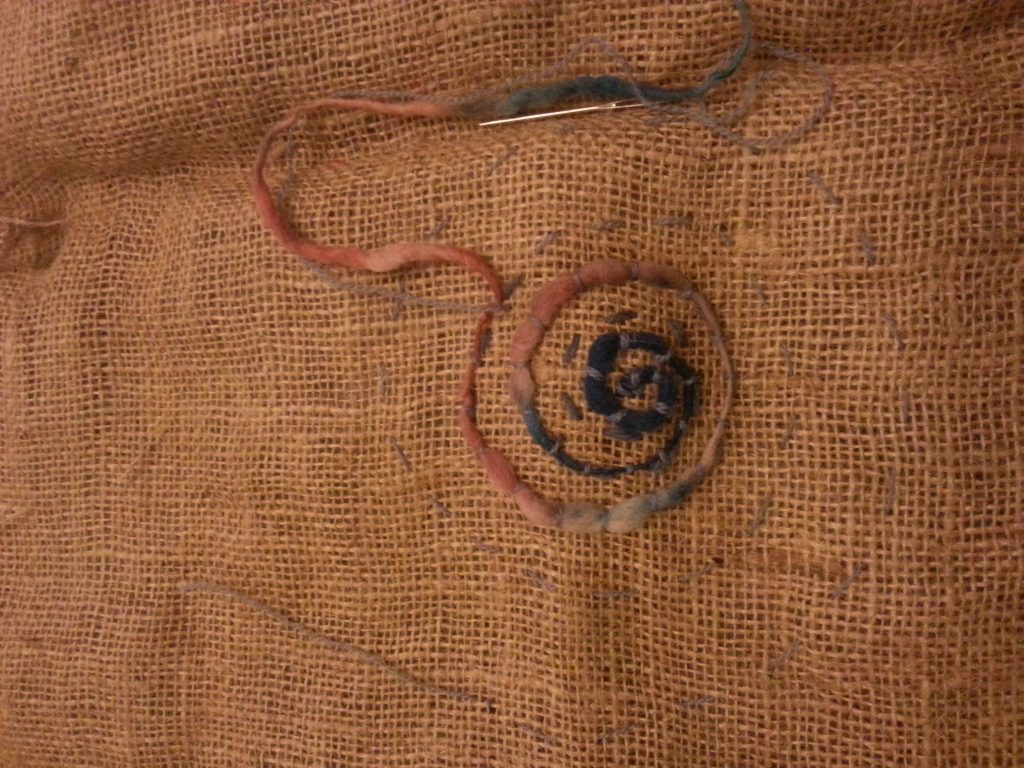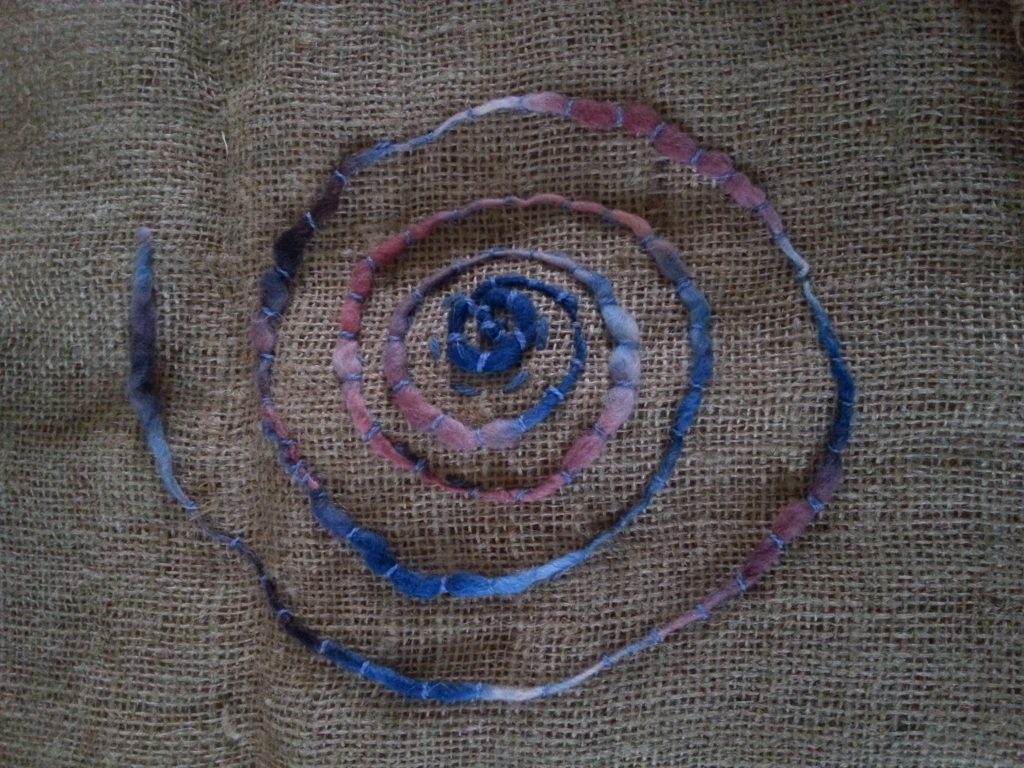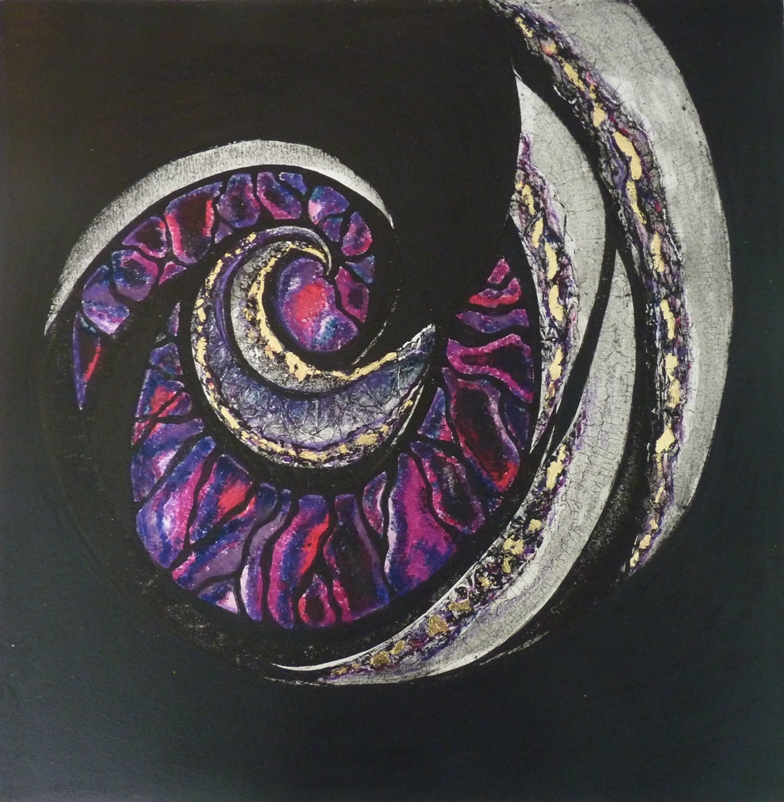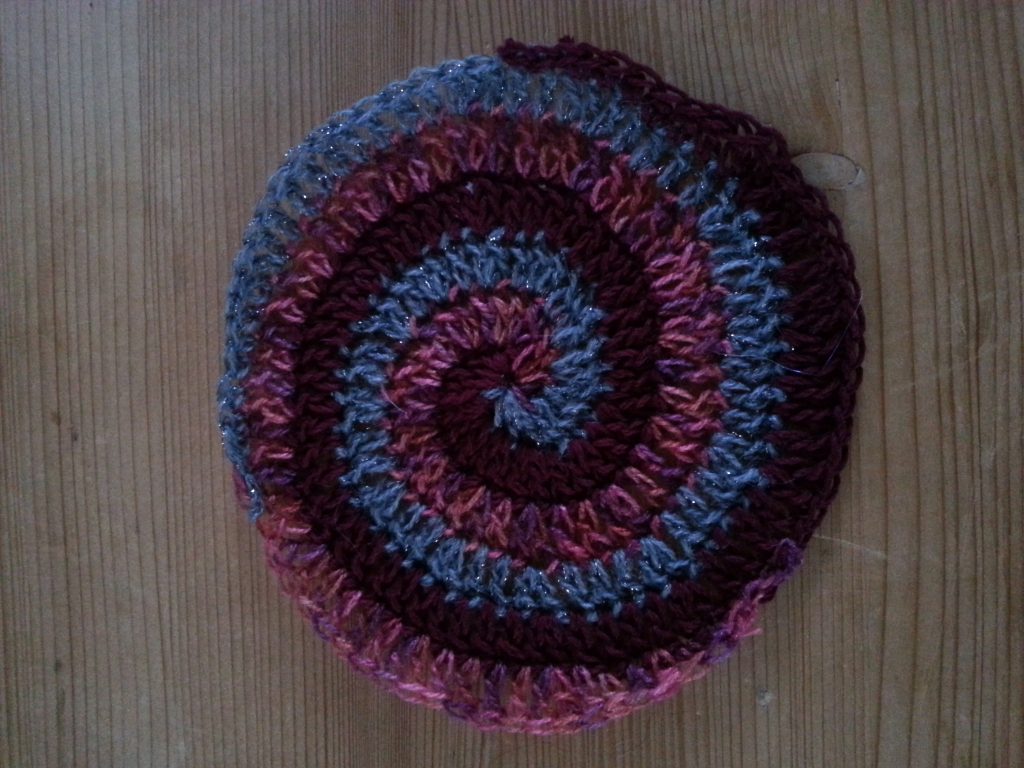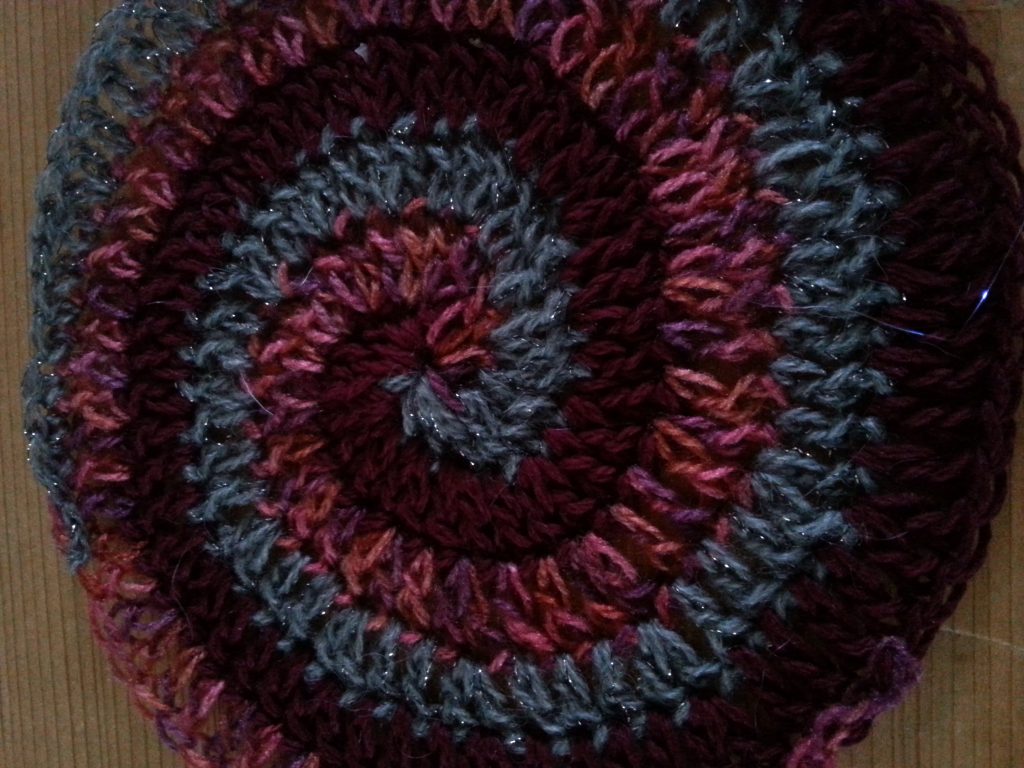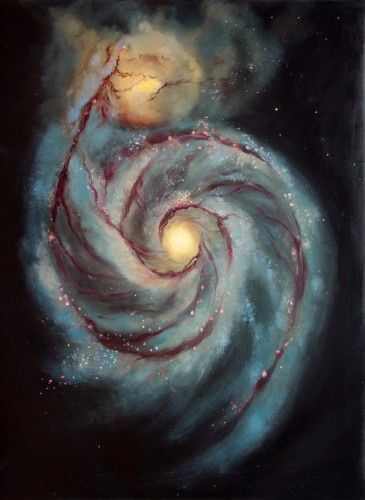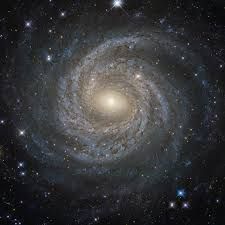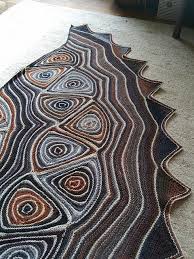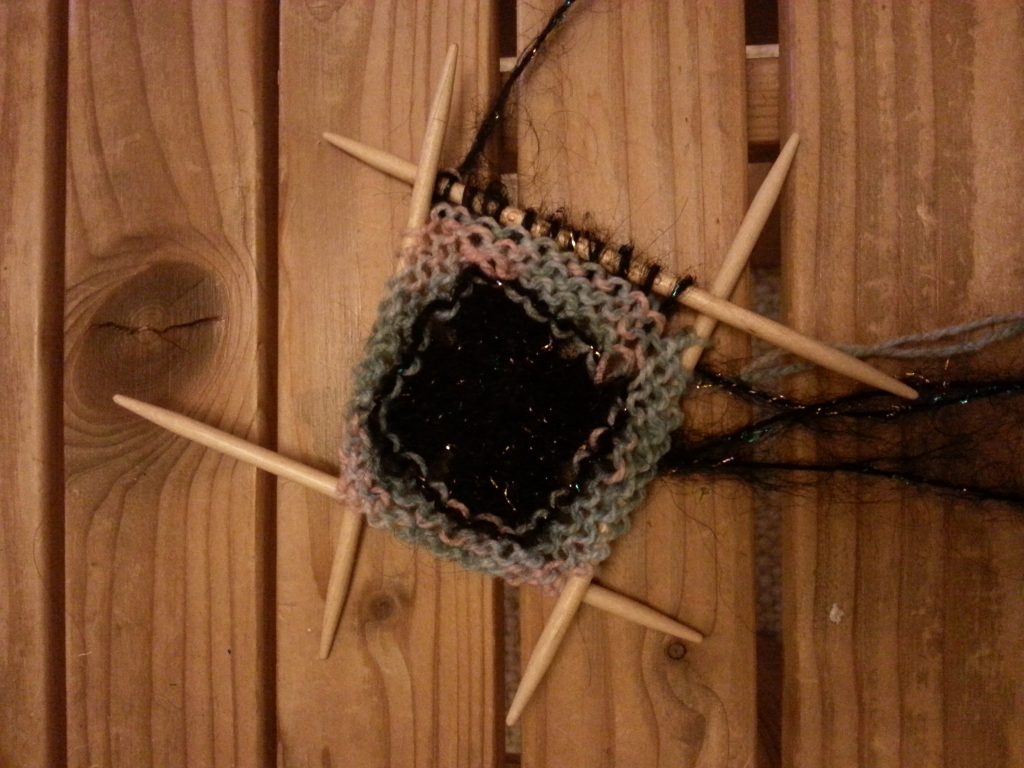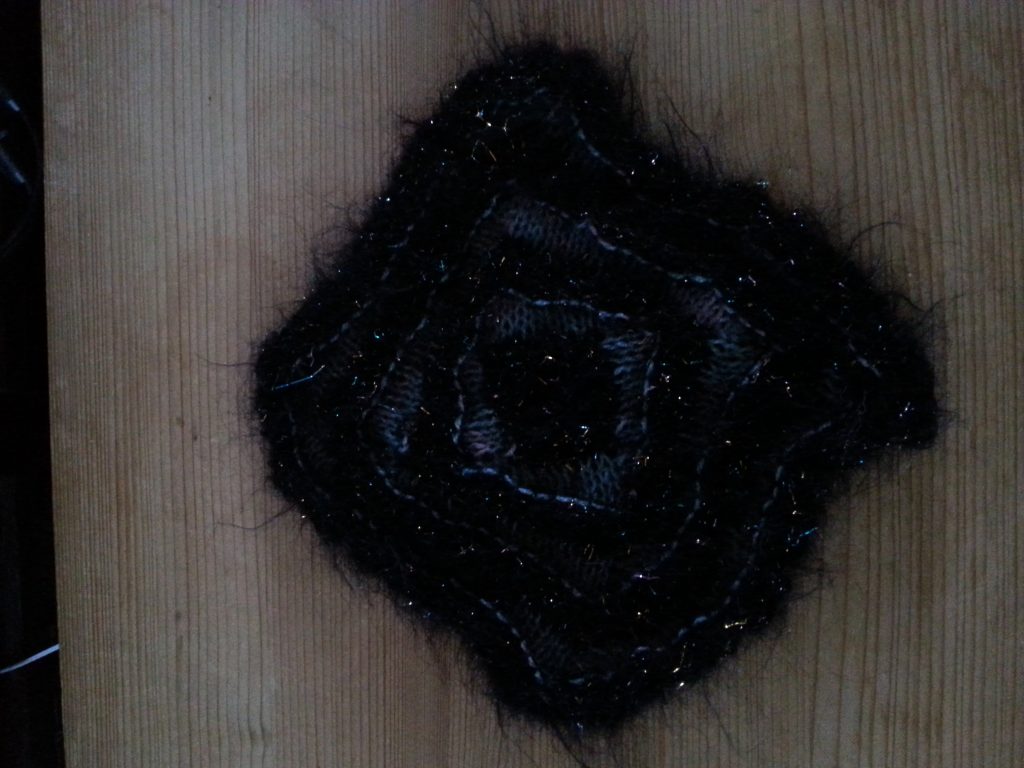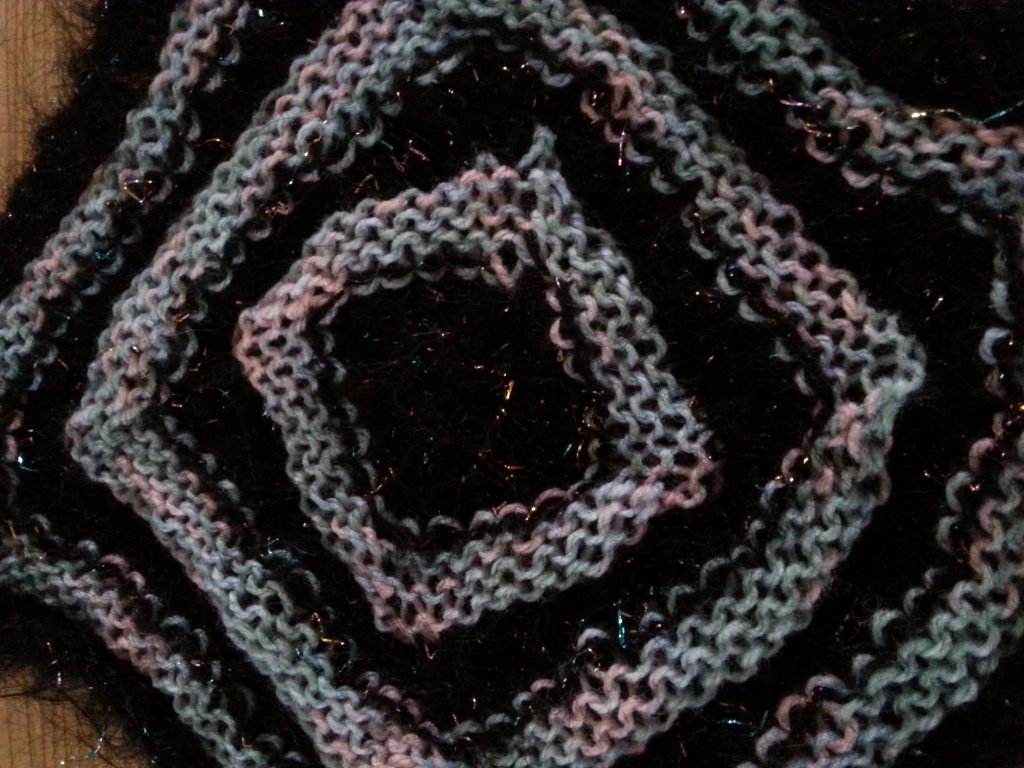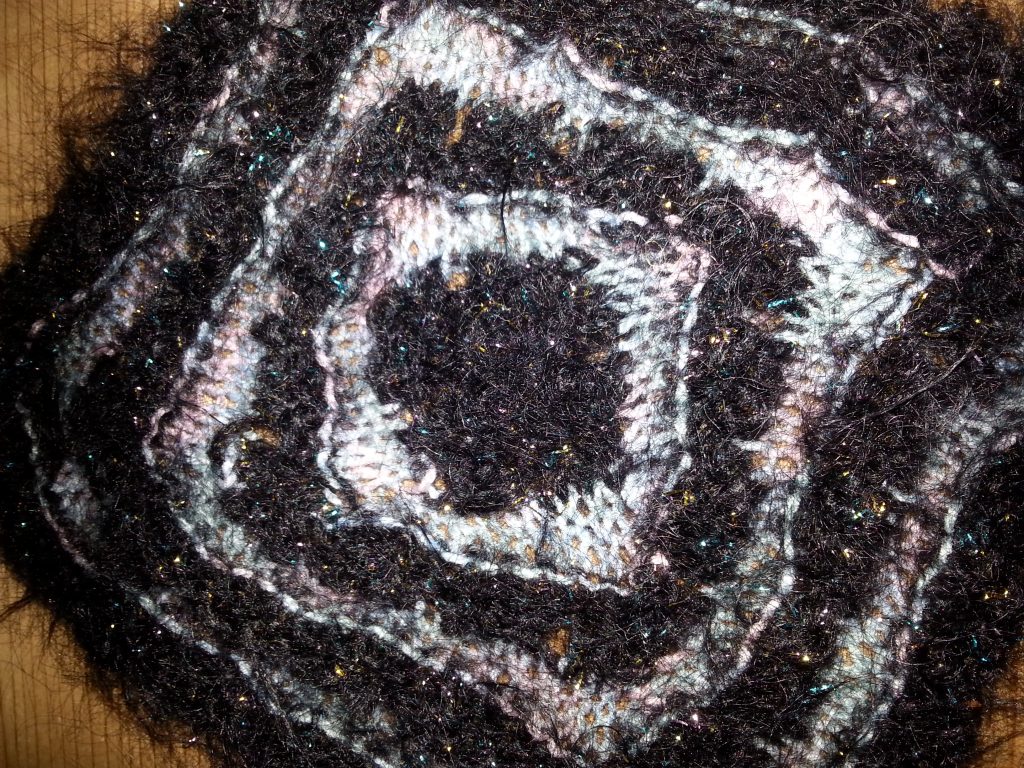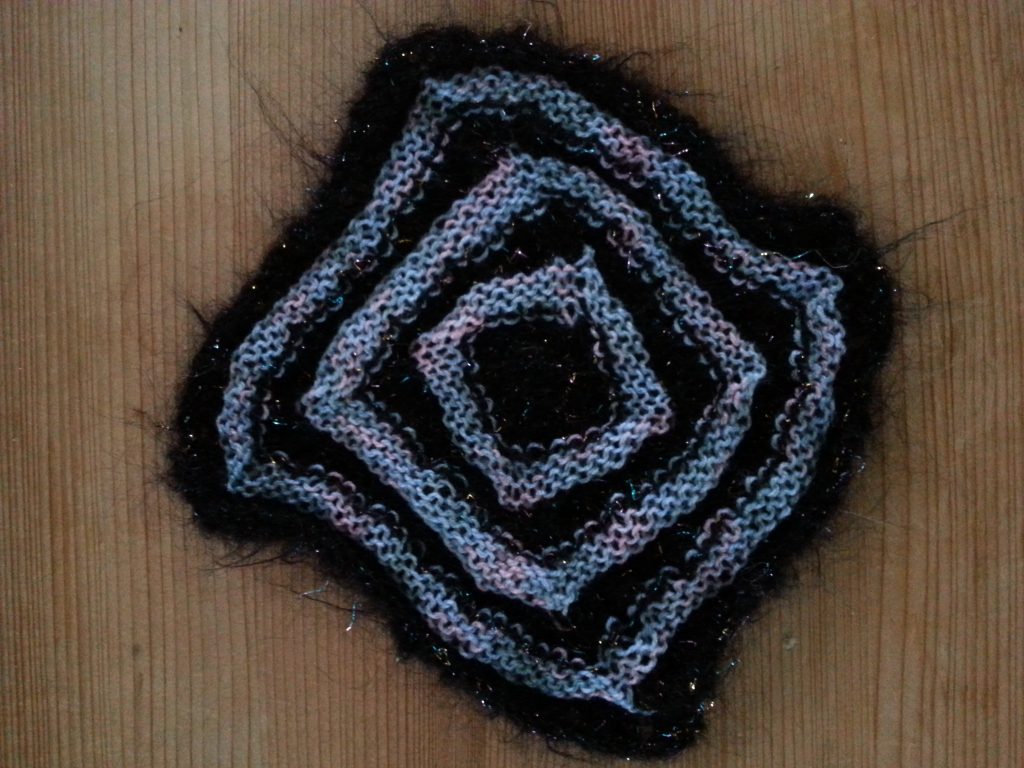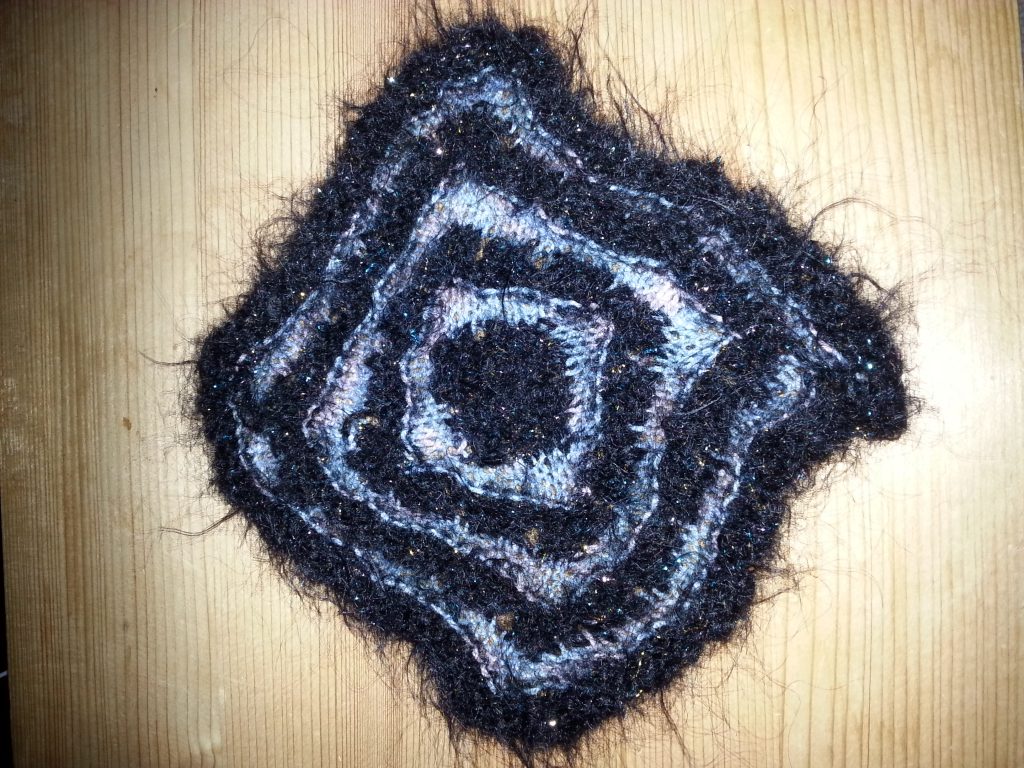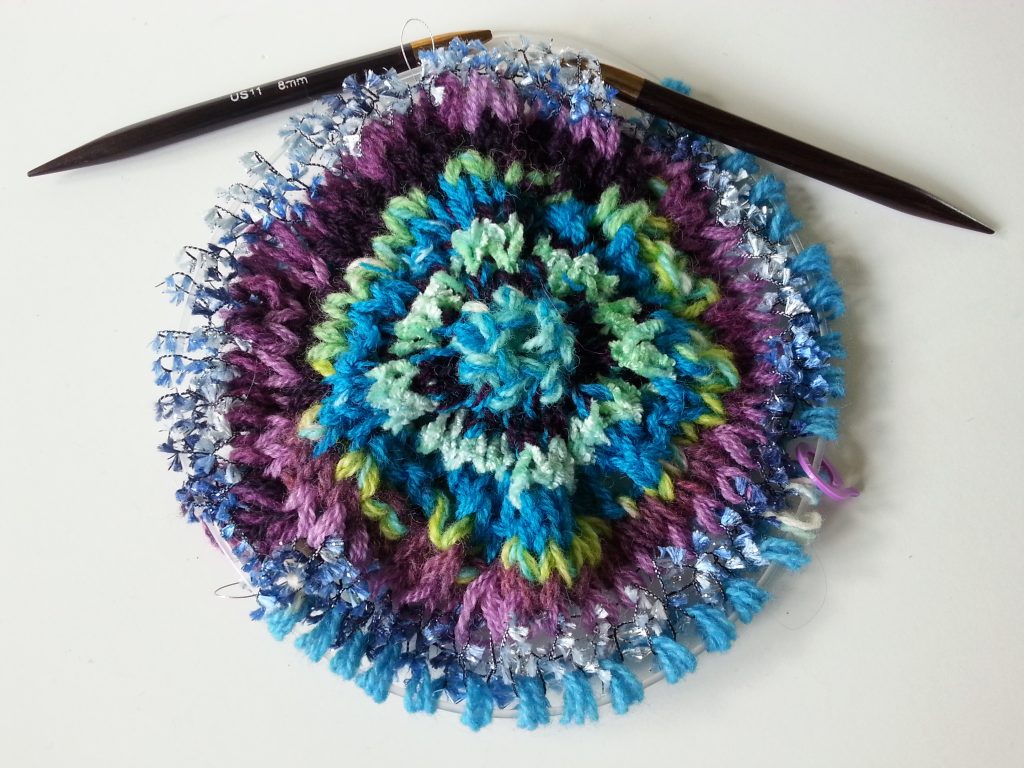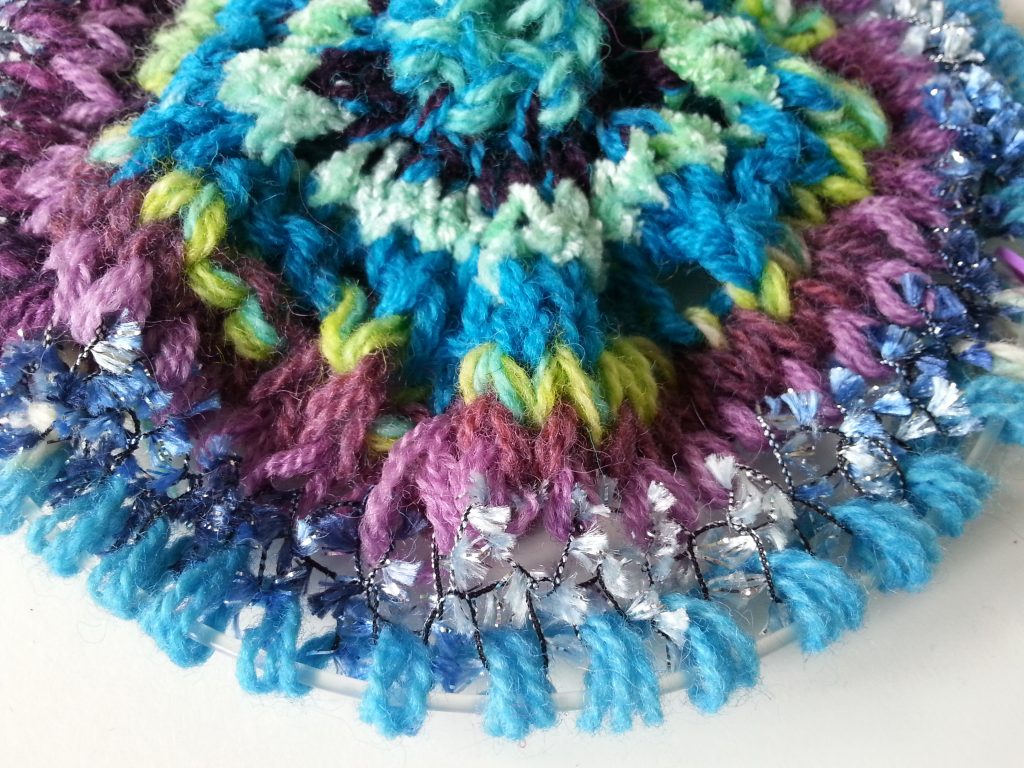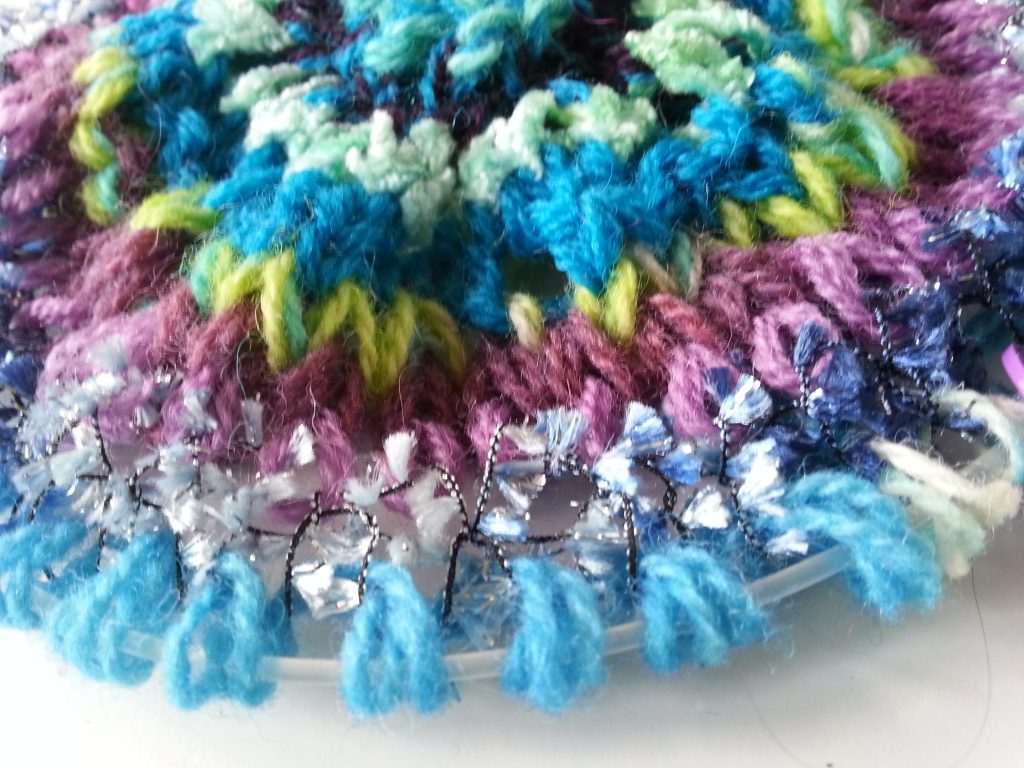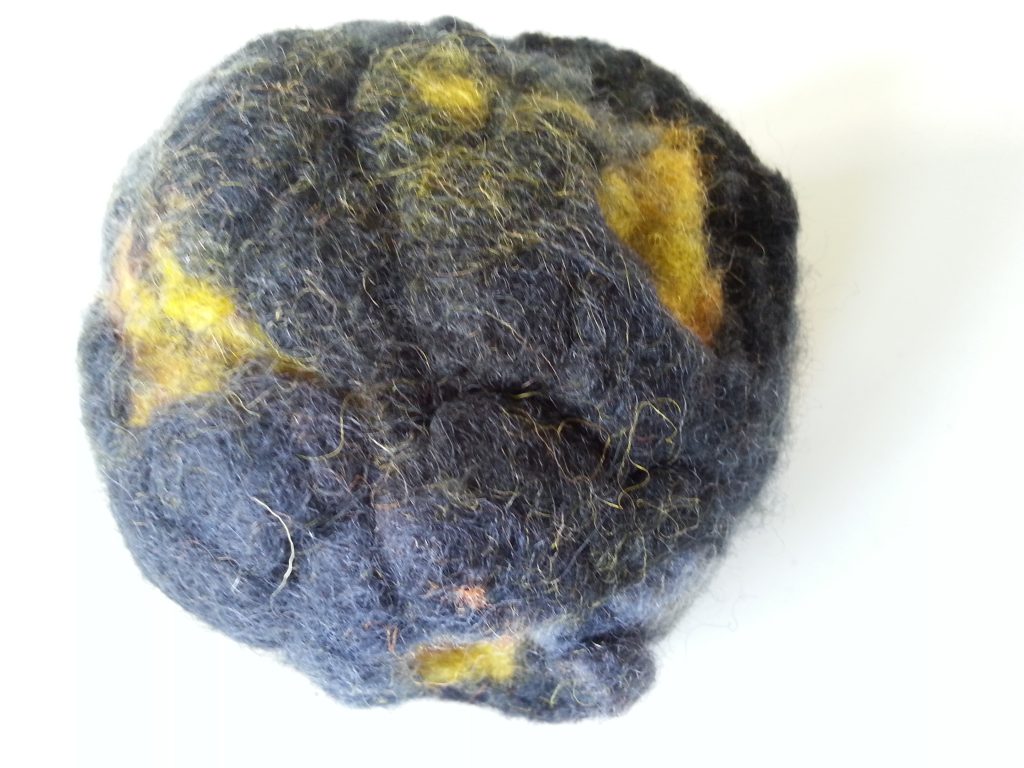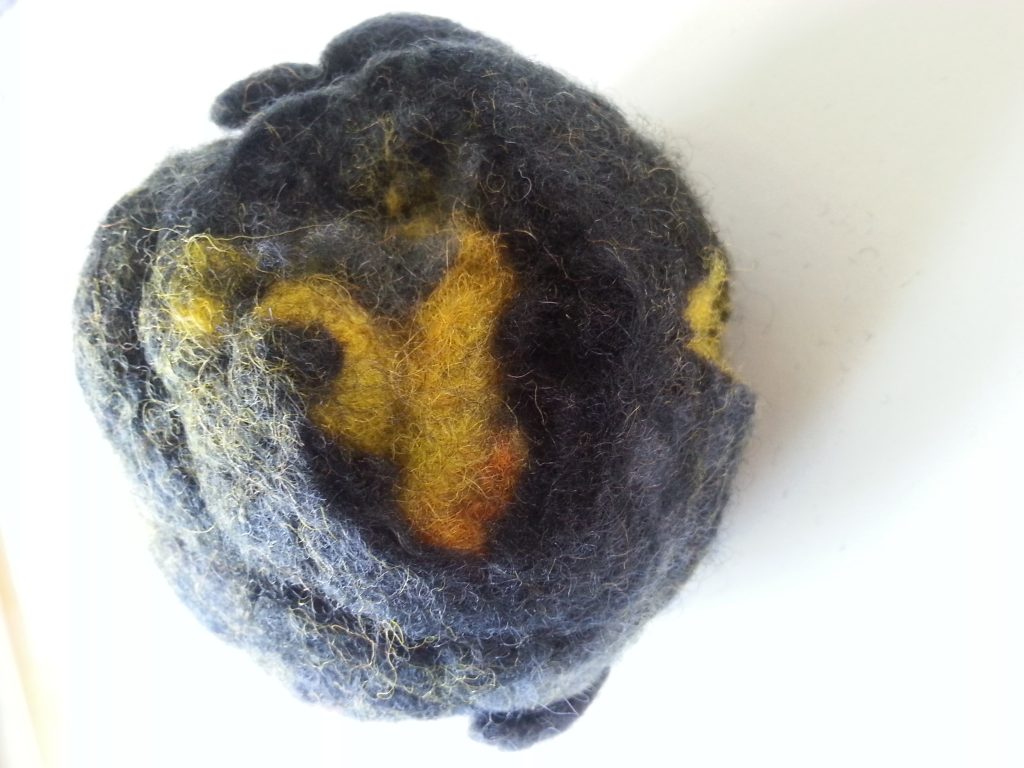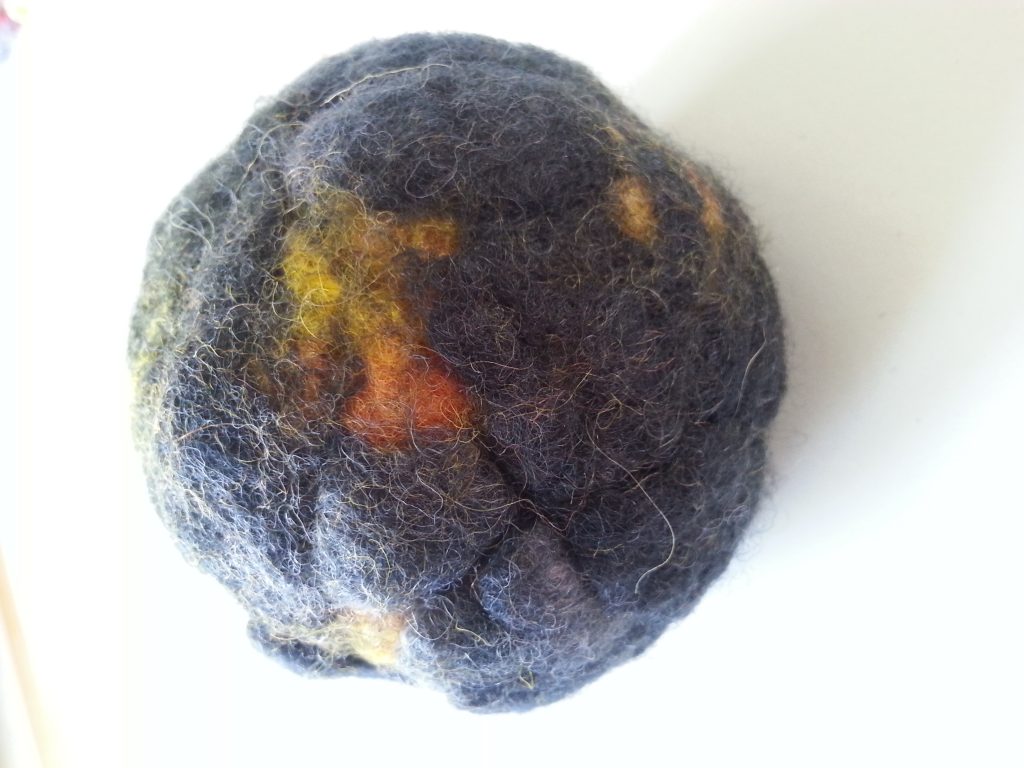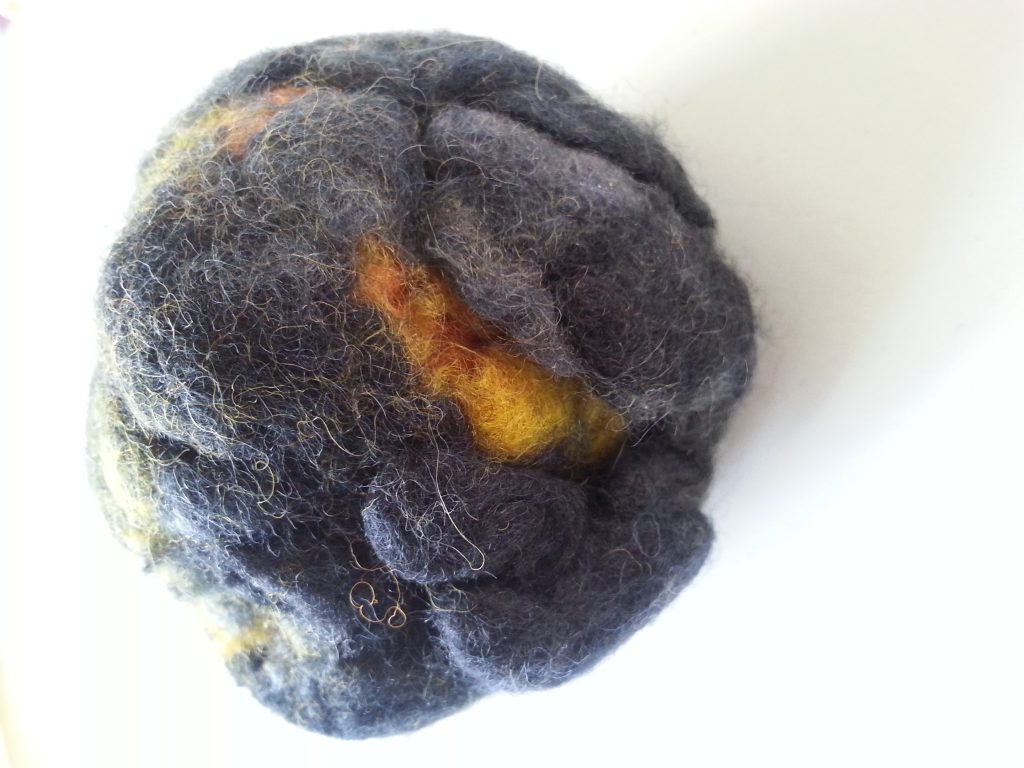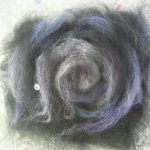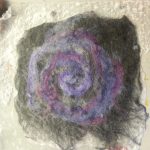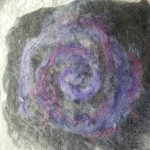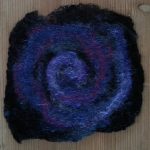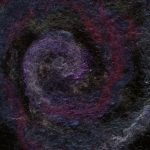At this stage I had no definitive idea as to the materials that would best suit my final piece. I therefore selected a range of media, drawing in part on inspiration and ideas from other artists’ work but also from the best outcomes from my work to date and additional technique research.
Fabric Paint and Shaving Foam on Fabric – Print Sample
This was a method I enjoyed very much in assignment four and it was fun to explore printing onto fabric. I tried two different designs. The first was a larger design inspired by images of galaxies and the milky way. For the second sample I chose richer colours, added a metallic fabric paint and created a smaller, repeating motif.
In each case the fabric paint was dropped onto the shaving foam and a wooden skewer used to distribute the paint. The fabric is then laid on the swirled paint, pressed down then pulled off carefully. A layer of foam remains on the print at this stage. After leaving for 10-15 minutes to allow the fabric paint to cure, the foam is scraped off with a flat edged scraper, revealing delightful, complex swirling patterns, entirely consistent with the explosion of gases, particles and light in a celestial sky.
- MMT Assignment 5 – Final piece – Research
- MMT Assignment 5 – Sketchbook
- MMT Assignment 4 – Sketchbook
- MMT Assignment 5 – Final piece – Sampling
- MMT Assignment 5 – Final piece – Sampling
- MMT Assignment 5 – Final piece – Sampling
- MMT Assignment 5 – Final piece – Sampling
- MMT Assignment 5 – Final piece – Sampling
- MMT Assignment 5 – Final piece – Sampling
- MMT Assignment 5 – Final piece – Sampling
- MMT Assignment 5 – Final piece – Sampling
- MMT Assignment 5 – Final piece – Sampling
Outcomes & Thoughts
I love this process. The technique is unusual but it is a very simple way to create complex marbling effects for a low cost. Once the fabric has been ironed the design is permanent and can be washed.
The designs produced are so complex as to make it difficult to enhance them successfully with embellishment, wadding or surface stitching. They are really just lovely as they are! For the purposes of the assignment, however, they don’t present opportunities to showcase the broad range of skills required and are rather ‘2-dimensional’. I will certainly be exploring this method further but don’t believe that this assignment is the right time/place.
Hessian and Wool – Stitched Sample
For this sample, I chose to develop the spiral motif of the Paleolithic and other ancient carvings, working on a background of hessian. A ground of stitches was laid in a spiral shape. A hand-dyed wool yarn with a thick-thin slub was laid through the stitches, wrapping to create additional texture.
- MMT Assignment 5 – Final piece – Research
- MMT Assignment 5 – Final piece – Research
- MMT Assignment 4 – Collatype – Exercise 3 – Collatype collage prints
- MMT Assignment 4 – Collatype – Exercise 3 – Collatype collage prints
- MMT Assignment 5 – Final piece – Sampling
- MMT Assignment 5 – Final piece – Sampling
- MMT Assignment 5 – Final piece – Sampling
- MMT Assignment 5 – Final piece – Sampling
Outcomes & Thoughts
For this sample I was drew inspiration from the simplicity of the Paleolithic engravings; the textured, natural-coloured hessian representing the stone and the simple stitching the rough-hewn, carved lines. I had thought that the raw hessian would provide suitable texturing against the stitched foreground.
Whilst it might be possible to take this design further, it is somewhat too simple for the purposes of this assignment. The materials did not immediately trigger any exciting ideas for development.
Mixed yarns – Crochet Spiral
In the search for a more interesting outcome I decided to explore the possibilities that might be offered by crochet. I have previously worked with crochet designs that exploit spiral and circle techniques and felt that these might give more satisfying results in interpreting the swirling galaxies. I took inspiration from one of the pieces of Kim Major-George – I love the swooping curves, the colour and the detailing in this piece. By choosing to work with a combination of variegated and single hue yarns I hoped to recreate this feeling of colour blending, shape and structure.
- MMT Assignment 5 – Final piece – Research
- MMT Assignment 5 – Final piece – Sampling
- MMT Assignment 5 – Final piece – Research
Outcomes & Thoughts
I feel that the sample echoes the tonal qualities in Major-George’s piece, with the deep burgundy taking on the deep shadows, the variegated rose-purple the purple-pink central tones and the blue-grey with metallic thread for the silvery highlights.
So, this piece ticks the boxes for shape and structure but again, it lacks liveliness and impact. It is rather flat; competent but with no real ‘zing’. It might be possible to enhance with interweaving of other materials, perhaps choosing fabric strips alongside the yarn? Or mounting onto a backing, perhaps wadding and adding stitch to any background. Onwards and upwards!
Mixed Yarns – Knit Sample One
It was a natural progression to go from the crochet sample and experiment with how the spiral motif might be interpreted and developed within the context of a knitted fabric.
I selected a range of yarns with contrasting textures, metallics and colours to give maximum impact. I then created a pattern design that would give a strong, lively textural fabric.
I took inspiration from our galaxy – the milky way, possibly the largest spiral of them all! A vast galaxy made of gas, dust, dark matter; home to many billions of stars, planets, and at its core, a supermassive black hole. I drew ideas for interpreting this concept from knitwear designers Svetlana Gordon. Both artists work extensively with textural and sculptural knits, taking knitwear beyond the ‘norm’ in terms of direction and structure.
- MMT Assignment 5 – Final piece – Research
- MMT Assignment 5 – Final piece – Research
- Svetlana Gordon – Jewel Dragon
- MMT Assignment 5 – Final piece – Research
- MMT Assignment 5 – Final piece – Research
- MMT Assignment 5 – Final piece – Research
- MMT Assignment 5 – Final piece – Research
- MMT Assignment 5 – Final piece – Research
Outcomes & Thoughts
This sample certainly fulfils my ‘textural’ criteria. The combination of rounds of knit and purl stitches, yarn overs and the use of different thickness and tension yarns creates deep ridges and a lovely stretchy, tactile fabric. The mohair yarn creates a soft fuzziness, reminiscent of the dust and gas clouds (and why our milky way is so called). The sparkle hints at stars and the strong contrast in the yarn colours gives powerful light and shade, emphasising the spiral nature of the design.
Nonetheless, although this sample is very interesting and fun and captures some of the features I was looking for, it still remains low on technique and is perhaps a little simplistic for this assignment. I’m not sure how well it demonstrates application of the preceding exercises in this module.
Mixed Yarns – Knit Sample Two
A technique I have used previously as a designer is to create felted fabrics from knitting. For this sample, I took that technique and selected a range of unusual and more familiar knitting yarns to work with. I intentionally selected yarns that would felt (wool and animal fibres) to work alongside non-feltable fibres (metallics, polyester, acrylics and ‘novelty’ yarns). The purpose was to explore the textures that arise when the feltable fabrics shrink during the felting process juxtaposed with the fibres that remain unfelted.
I followed the spiral theme, knitting in the round on circular needles. I chose a colour palette based on a spring theme, selecting colours and yarns instinctively, joining roughly with simple knots as and when each yarn ran out. I worked on over-sized needles to create enough ‘space’ for the shrinkage process and to give the opportunity for maximum visibility of the differences in shrinkage properties.
- MMT – A Final Piece – Knit Sample
- MMT – A Final Piece – Knit Sample
- MMT – A Final Piece – Knit Sample
Outcomes & Thoughts
A piece in progress! I wasn’t feeling inspired by this piece so I’ve parked it for now and may come back to it later. It didn’t really fit my vision of the spiral theme and, whilst I like the colours, I think there may not be enough feltable fibres so I’m going to come back to this at some future point and possibly re-start with different yarns.
Felt sample – Wool ball
I have previously worked with felt and particularly value it as a means of making very versatile fabrics. It can be 2-dimensional, 3-dimensional, soft enough for a scarf or tough enough for a home! There are so many fabulous artists who work in felt, some, such as Anneke Copier, I have researched earlier in the course. I have since discovered other artists, Jana Muchalski for her amazing use of colour, Yukako Sorai, whose cut-felt forms are wonderful for their shape, depth and exciting use of colour; Stephanie Metz for her incredibly tactile, fluid organic forms and Dagmar Binder’s stunning high fashion felt.
For this sample, I took the idea of natural forms from Metzs’ work, in my case, a meteorite/volcanic rock. I created many layers of colour, working from deep red in the ‘core’, through orange to yellow. The ‘surface’ is worked in charcoals and greys to reflect the outer surface of the cooling geological form. Working in a manner inspired by Sorai’s cut work, I cut sections from the ‘rock’ to recreate the piece – the interior intense hot red, cooling as it reaches the surface. The natural ripples in the felt were left in place (in contrast to Sorai’s smooth surfaces) as I wanted an impression of pyroclastic flow, rising out of the earth molten, cooling and setting in organic, swirling shapes. The cut areas dig deep into the still-molten core, revealing the hot centre.
- MMT – A Final Piece – Felt Sample 1
- MMT – A Final Piece – Felt Sample 1
- MMT – A Final Piece – Felt Sample 1
- MMT – A Final Piece – Felt Sample 1
Outcomes & Thoughts
My first attempt at this technique was in Assignment 3 and it was something I had planned to revisit. I usually work with much smaller, bead-sized balls so scaling up the process was very exciting. Normally I would be looking for a perfectly smooth outer so in order to resist the temptation, I adopted the same technique as in Assignment 3 and stuffed handfuls of coloured fleece (rather than the usual smooth roving) into a bag. By manipulating the fleece in the bag, I created rough layers of colour, finishing with an outer layer of the charcoal. This was felted in the washing machine, producing a ‘rough-hewn’ ball of ‘rock’.
I like this piece. It is texturally very exciting, tactile and fun to hold. I could have been more adventurous with the cuts but I was worried the ball might fall apart! As it is, there are sections that have worked well. I like the way that in some places the colour is just visible beneath the surface, in others I have dug deep into the fibre and really pulled out the core. Next time I’ll be more confident!
Felt sample – 2d flat-felt
I enjoyed working with the felt and thought that it would be useful to try a further sample using a different technique. Taking the galaxy spirals motif as the inspiration for the design I created a flat felt sample with wool roving. I added angelina fibre to lift the design and give the impression of a galaxy of stars and light, embedding the non-feltable angelina between layers of the feltable wool.
- MMT Assignment 5 – Final piece – Research
- MMT Assignment 5 – Final piece – Research
- MMT Assignment 5 – Final piece – Research
- MMT Assignment 5 – Final piece – Research
- MMT Assignment 5 – Final piece – Research
- MMT Assignment 5 – Final piece – Research
- MMT Assignment 5 – Final piece – Research
Outcomes & Thoughts
I had high hopes for this piece! Before felting the texturing and colours looked really exciting and promised a good outcome. Unfortunately, by the time the piece had been felted the texturing was gone, the shapes and colours had become quite bland and the felt was very thin and insubstantial. I should have realised that there wasn’t enough wool for a thicker piece of felt – it compacts down significantly due to the felting process. The lack of texture was also obvious on reflection. Clearly pressing and rubbing the felt to make it into a fabric wasn’t going to leave texture in the way that I had hoped.
Outcomes – Conclusion
At the end of this first sampling stage I put all the pieces to one side to allow me to view them again in a fresh light. After a couple of days, I put them all out and briefly reviewed the work carried out for earlier exercises. I also re-read my artist research to see how my pieces had drawn on the aspects of their work that I found particularly engaging.
Having reflected carefully and critically, in terms of materials, I am moving on from printing as this offers limited scope for depth and texturing (adding stitch to a simpler design might be an option). The stitching onto canvas wasn’t only a very quick sample, but didn’t excite me enough to feel that I want to explore it further. The knitting and crochet samples are starting to add texture, the colours are more interesting and the ability to control the design is quite controllable and predictable (this could be both a good and bad thing!). The felting samples are clearly ahead in terms of the scope for development of texture, shape and ability to manipulate the material (density, 2d/3d, moulding, stitching).
The next step will be to do further research on felting techniques, artists who work in felt and also to think about colour and pattern.
